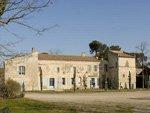The bulls and the vine bath by bike
On the way to Saint Jacques de Compostela, surrounded by landscapes shaped by the hand of winegrowers, Camargue bulls accompany you along the paths unveiling the vineyards of the Pays d'Arles. A stroll in the heart of the Camargue terroir and rural heritage!
8 points of interest
 Patrimony and history
Patrimony and historyThe wooden arenas of Gimeaux
6 km from Arles is Gimeaux, a small Camargue village where fighting bulls are parked in corrales before the bullfights. Generally attached to the arena, these corrals are located in Nimes and Arles, located outside the city. Bulls can be seen by visitors and aficionados (bullfighting enthusiasts) before the show. They are then brought by truck to the toril, a room adjoining the arena where the bulls are locked before the start of the race or corrida.
 Elevage et pastoralisme
Elevage et pastoralismeThe bull of Camargue
The bull of Camargue, also called bull of Raço di Bioù, is slender and fiery. It sports beautiful horns shaped lyres. Its breeding is mainly intended for the Camargue race, also called race "with the cockade". It can also be admired during ferrades, during which the anouble, a young bull of one year, is separated from the herd to be affixed a fire brand. His Spanish counterpart is for bullfighting, which is a true Iberian tradition.
 Produits du terroir
Produits du terroirPDO bull meat from Camargue
In 1996, bull meat was the first red meat to obtain the Appellation d'Origine Contrôlée (AOC). It gets the Protected Designation of Origin in 2011. In addition to the delimitation of a strict geographical area where the animal must be born, bred and slaughtered, the farms must meet specifications that impose in particular the exclusivity of breeds of Biòu and Combat and the practice of extensive breeding. Bullfighting in the Camargue is mainly for bull games.
 Patrimony and history
Patrimony and historyThe Saliers village and his Templiers
The name of Saliers (Salliers) comes from the fact that the village was a deposit of salt until 1246. A second etymological hypothesis is based on a Provençal derivative: salo (room, then house, castle). In the Middle Ages, Saliers is one of the largest agricultural estates in the Camargue. Particularly fertile, the whole area was covered with wheat fields, meadows, fruit trees. At this time, les Templiers, then les Hospitaliers de Saint-Jean-de-Jérusalem are the lords.
 Elevage et pastoralisme
Elevage et pastoralismeThe Guardian Hut
Traditional home of guardians of Camargue, the hut has whitewashed walls and a roof of sagne (reeds marshes). The architecture of these cabins is original : straight walls on all sides except the one exposed to the mistral (north-west) which is in apse (of rounded form) to offer less catch in the wind. At the top of this apse, there is usually a form of cross or horn that used to stow the cabin on the ground during windy days. Patrimony and history
Patrimony and historyThe old Bühler cellars and winegrowing in the Camargue
It is at the end of the 19th century. that the Camargue, hitherto dedicated mainly to the cultivation of wheat, turns to the vine. The possibility of flooding the lands via the proximity of the Rhone, allowed from the 1870s, to drown the phylloxera parasite larvae that ravaged the vineyard throughout France. The Camargue vineyard was able to flourish (8000 ha in 1930) as illustrated by the presence of the old Bühler cellars, one of the largest vineyards in the Camargue.
 Produits du terroir
Produits du terroirThe Pays d’Arles wine
The vineyard of the Pays d'Arles represents approximately 1,000 ha. Twenty-five winemakers have joined forces in a syndicate and cultivate traditional grape varieties (Grenache, Syrah, Cinsault and Carignan), which they have associated with noble grape varieties (Chardonnay, Sauvignon, Merlot, Marselan, etc.). Some areas are in organic farming or sustainable agriculture. The quest for quality and novelty has resulted in a wide range of quality wines, offering the three colours: red, white and rosé
 Patrimony and history
Patrimony and historyThe road of Santiago de Compostela.
The road to Santiago de Compostela recalls the Apostle James present during the life of Jesus and who would have been decapitated around 41-44. It is only under Charlemagne and Alphonse II the Chaste (759-842) that his tomb is discovered in Galicia, Spain. Many faithful pay tribute to him on this road. The Via Tolosana from Arles is one of four routes that cross France to the tomb of Santiago. Some houses have the emblem of pilgrims: A shell.
Description
From the Tourist Office, turn left on Boulevard des Lices then turn right on Gambetta street towards Trinquetaille. Cross the Rhône and continue towards Saintes-Maries-de-la-Mer.
1- At the roundabout, take the C108 direction Gimeaux.
2- Turn left after the arena and follow the C113 "Palunlongue path".
3- At the crossroads of the D37, turn right for 500 m then turn right on the C118 road to the Saliers hamlet.
4- At the junction of the D572, turn right towards Arles for 500 m. Take on the left the road from Cazeneuve to Rigaudon.
5- At the old railway line, take the road opposite.
6- At the junction, cross the railway and take the VC105 "Chemin des Prêcheurs" on the right. At the stop turn right.
7- At the stop, turn left on the old road to Saint-Gilles, direction Trinquetaille.
- Departure : Tourist Office, Arles
- Arrival : Arles
- Towns crossed : Arles
Forecast
Altimetric profile
Recommandations
At the intersection of the D572, dangerous road, caution!
Respect the rules of the road on roads open to public traffic.
On the old road of Saint-Gilles, attention, dangerous road!
Information desks
the Camargue museum
Mas du pont de rousty, 13200 Arles
Remember to visit the Camargue museum! It is located next to the administrative centre of the Camargue Nature Park.
OT Arles
9 Boulevard des Lices, 13200 Arles
Access and parking
Departure from the Arles Tourist Office located boulevard des Lices.
Parking :
Accessibility
Report a problem or an error
If you have found an error on this page or if you have noticed any problems during your hike, please report them to us here:


